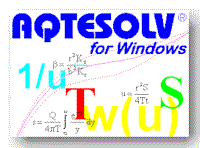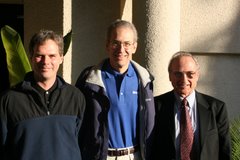Upon its release in 2006, AQTESOLV/Pro v4.0 became the first aquifer testing software to feature groundwater mounding calculators that predict the transient rise and decay of the water table beneath rectangular and circular recharge areas (Hantush 1967). Using AQTESOLV, you may compute the maximum rise of the water table and generate contours of a groundwater mound with ease.
The example plot (above) shows a 3-D contour plot of a groundwater mound developed around a hypothetical rectangular recharge area. Applications for the groundwater mounding calculators in AQTESOLV include infiltration from septic systems and recharge from stormwater impoundments.
Visit the AQTESOLV web site for more information on the Hantush (1967) solutions for groundwater mounding prediction.
Sunday, November 1, 2009
Saturday, June 20, 2009
ASTM "Standards"
ASTM publishes "standards" on many subjects including aquifer test analysis. ASTM D5912-96 (2004) entitled Standard Test Method for (Analytical Procedure) Determining Hydraulic Conductivity of an Unconfined Aquifer by Overdamped Well Response to Instantaneous Change in Head (Slug) is one such ASTM standard. You'll spend $32 to obtain a copy of this four-page standard from ASTM, but don't expect to get completely accurate information for your investment.
ASTM D5912-96 (2004) describes a widely used method of slug test analysis devised by Bouwer and Rice (1976). The standard contains an equation (ASTM D5912-96 (2004), p. 2, Equation [2]) used in the Bouwer and Rice method to calculate the parameter ln(Re/rw) when D (the aquifer thickness) is greater than H (the penetration of the well) as follows:

The ln(Re/rw) parameter is used in the Bouwer and Rice method to calculate the hydraulic conductivity K from a slug test.
Unfortunately, the above equation from ASTM D5912-96 (2004) is incorrect. The correct form of this equation (Bouwer and Rice 1976, p. 425, Equation [8]) is written as follows:

As one can see from a comparison the two foregoing equations, the ASTM version misplaces the term L/rw and leads to a completely erroneous estimate of ln(Re/rw).
Am I just nitpicking here? I don't think so. It's hardly unreasonable to expect thorough attention to detail from a publication put forth as a "standard" such as ASTM D5912-96 (2004). Certainly, the basic equations that are central to such a standard should be checked carefully and published without error. ASTM standards purportedly go through a rigorous review process. Yet ASTM D5912-96 (2004), adopted in 1996 and subsequently reapproved in 2004, still contains the flawed equation. One is left to wonder how many other "standards" relied upon for aquifer testing contain similar fundamental errors.
ASTM D5912-96 (2004) describes a widely used method of slug test analysis devised by Bouwer and Rice (1976). The standard contains an equation (ASTM D5912-96 (2004), p. 2, Equation [2]) used in the Bouwer and Rice method to calculate the parameter ln(Re/rw) when D (the aquifer thickness) is greater than H (the penetration of the well) as follows:

The ln(Re/rw) parameter is used in the Bouwer and Rice method to calculate the hydraulic conductivity K from a slug test.
Unfortunately, the above equation from ASTM D5912-96 (2004) is incorrect. The correct form of this equation (Bouwer and Rice 1976, p. 425, Equation [8]) is written as follows:

As one can see from a comparison the two foregoing equations, the ASTM version misplaces the term L/rw and leads to a completely erroneous estimate of ln(Re/rw).
Am I just nitpicking here? I don't think so. It's hardly unreasonable to expect thorough attention to detail from a publication put forth as a "standard" such as ASTM D5912-96 (2004). Certainly, the basic equations that are central to such a standard should be checked carefully and published without error. ASTM standards purportedly go through a rigorous review process. Yet ASTM D5912-96 (2004), adopted in 1996 and subsequently reapproved in 2004, still contains the flawed equation. One is left to wonder how many other "standards" relied upon for aquifer testing contain similar fundamental errors.
Tuesday, April 28, 2009
AQTESOLV in Boston
Today marks the beginning of our three-day Advanced Aquifer Testing Techniques Featuring AQTESOLV: New Concepts, Field Methods and Data Analysis Procedures short course at the Waltham Wood Conference Center outside of Boston, MA. Presented in cooperation with the Midwest Geosciences Group, we have been offering this course every year since 2006. The course covers aquifer testing topics pertaining to slug tests and pumping tests. As part of each day's activities, course participants gain hands-on experience with the AQTESOLV software using data from real-life field investigations conducted in a variety of hydrogeologic settings.
 Last year (2008) seemed to come and go very quickly owing to an extremely busy schedule! We presented our three-day aquifer testing course featuring AQTESOLV in San Antonio, TX to a large audience and also taught well-attended two-day seminars in Waterloo, ON, Canada as well as Ft. Collins, CO. A wonderfully exciting time for me was a three-week period in November and December 2008 when I traveled to Australia to participate in the instruction of short courses on fractured bedrock in Melbourne and Sydney.
Last year (2008) seemed to come and go very quickly owing to an extremely busy schedule! We presented our three-day aquifer testing course featuring AQTESOLV in San Antonio, TX to a large audience and also taught well-attended two-day seminars in Waterloo, ON, Canada as well as Ft. Collins, CO. A wonderfully exciting time for me was a three-week period in November and December 2008 when I traveled to Australia to participate in the instruction of short courses on fractured bedrock in Melbourne and Sydney.
 Last year (2008) seemed to come and go very quickly owing to an extremely busy schedule! We presented our three-day aquifer testing course featuring AQTESOLV in San Antonio, TX to a large audience and also taught well-attended two-day seminars in Waterloo, ON, Canada as well as Ft. Collins, CO. A wonderfully exciting time for me was a three-week period in November and December 2008 when I traveled to Australia to participate in the instruction of short courses on fractured bedrock in Melbourne and Sydney.
Last year (2008) seemed to come and go very quickly owing to an extremely busy schedule! We presented our three-day aquifer testing course featuring AQTESOLV in San Antonio, TX to a large audience and also taught well-attended two-day seminars in Waterloo, ON, Canada as well as Ft. Collins, CO. A wonderfully exciting time for me was a three-week period in November and December 2008 when I traveled to Australia to participate in the instruction of short courses on fractured bedrock in Melbourne and Sydney.
Subscribe to:
Comments (Atom)



